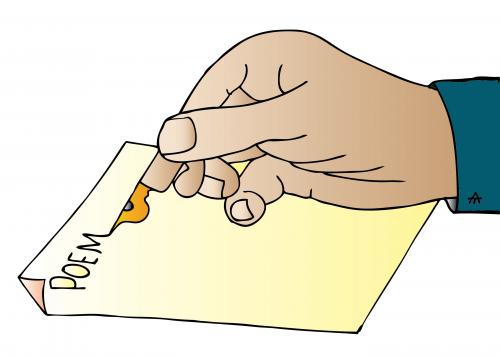About Shel Silverstein: Born in 1930, in the City of Chicago, U.S., Sheldon Allan Silverstein went on to become a man of many talents. He was in his lifetime a poet, a singer and songwriter, a cartoonist and author of many children’s books. His most notable works include ‘Where the Sidewalk Ends’, ‘The Giving Tree’ and ‘A Boy Named Sue’. He received many prestigious awards for his works including two Grammy awards. His style of writing poetry which was laidback and conversational was easy to understand by the general populace. He died in 1999 of a heart attack at the age of 68.
About Plastic: It is more apt to categorize ‘Plastic’ as a song rather than a poem, though it can also be called a poem. As said before, Shel Silverstein was a songwriter, besides being an accomplished poet. One of the songs he wrote is ‘Plastic’. It was released in 1965. The music was composed by Silverstein himself.
Setting of the poem: The first setting of the song/poem is inside a house. The main character of this first part is a termite. He comes into the speaker’s house and tries eating it. The second setting of this poem is outside, in the beach. The speaker clearly mentions these places and hence the settings, in the poem.
Poetic Devices in the poem Plastic
Rhyme: There is rhyme in the poem but there is no concrete rhythm. The end words of lines 2 and 4 rhyme. Then end words of lines 6-9 and 7-8 rhyme. The end words of lines 1,3,5 do not rhyme with anything. Hence there is rhyme for certain, but there is no concrete format or rhythm to it.
Repetition: The word ‘plastic’ is used multiple times in the poem, thrice alone in the last two lines. The last two blocks of verses end the same way with the same line: everything’s gonna be plastic by and by. In line 1 and 2, use of ‘knockin’ knockin’’ is seen.
Hyperbole: The speaker repeats two times that everything is going to be plastic in coming times. But there is no way that can be possible. There are a lot of things which cannot be made by plastic and the expression is only used to say how fast and how wide the world is using plastic.
Personification: The termite in the poem is shown knocking on the door. It is shown crying that it was all plastic and that he can’t eat it. In short, it was given human characteristics, both speech, and emotion.
Irony: Lines 2 and 3 speak of the termite chewing the floor, the walls, the ceilings and what not. One expects it to get fat after eating so much but in line 7, the contrary is said to be the fact. This here is irony.
Apostrophe: Use of knockin’ knockin’ in line 1 and 2, nibblin’ in line 4, and getting’, bathin’ and passin’ in the following lines.
Plastic Summary by Shel Silverton
The speaker of the poem sees a tiny termite enter his home. It sits down on the kitchen floor and starts chewing on it. It then moves onto the walls, the ceilings and the hall. But try however it might, it cannot chew on anything. He kept getting thinner and thinner because of this.
He could not bear it any longer and so he cries out loud that everything he tried to eat was made of plastic. It wasn’t wood, which he could eat, but plastic. He laments that everything would be made of plastic soon.
The speaker goes in the month of June to the beach. There he sees woman in their bathing suits all within his reach. As he does so, he sees a particular woman with curves that make him intrigued. He asks her how he got those curves. She replies that it was all plastic. She says that it is pretty, but it isn’t really her. She too says that everything would be plastic as time goes on.
Plastic Analysis by Shel Silverton
The termite is first introduced in the poem and given human characteristics. Personification is seen here as it is said to come knocking on the front door into the house. Humor is induced right away with the sentence ‘He walked right in, sat right down’. The sentence construction and the imagination of the termite doing the walking and sitting process make sure of that.
Further humor follows with the termite trying to eat and not being able to. It is only amplified when the termite is said to cry out loud in exasperation that there was no wood but only plastic.
Humor is further implied in line 3 of paragraph 3, when ‘cuties’ and ‘beauties’ is put in one single verse; and in the conversation between the speaker and the beauty with the 38-24-36 measurements too.
It can be said that there are deep implications in this poem. It can be said to show how humans’ lives are getting increasingly dependent on plastic. Plastic is in most regions a synonym with ‘fake’. The poem can be said to be a pointer to the increasingly ‘fake’ lives humans are beginning to lead. Whereas once there was real wood, now plastic is used. Whereas once achieving a good body was one fraught with hard work (read restraint) and dedication, it is now easy to get one with a plastic surgery.
In fact, the woman in the poem admits it herself. ‘It’s pretty as can be, but you know it ain’t me’. This line shows the woman kind of regretting undergoing that plastic surgery because she realizes that it wasn’t really her now that the world is seeing. Either that or she doesn’t care if anyone knows that she achieved her body with plastic, because sooner or later “everything’s gonna be plastic”.
Either implication is a disturbing one. Realizing that she was ‘fake’ too late (after undergoing that surgery) hurts because she now has to live with that. Surrendering to the thought that as everything is going to be plastic by and by, and going ahead to exchange one’s real self with that of a one with ‘plastic’ included, means that the world is soon going to be filled with perfect fake people.
It can be said to be kind of a caution. But as said before, this is only one interpretation of the poem. Another interpretation is that it was written in a lighter mood and only intended as a humorous work. The facts supporting this would be the hyperbole in the poem, the repetition, the setting and the tone. The nature of the poet, Silverstein himself, shows that this particular work was written more in jest than in fervor.
Central Idea of the poem: The poem is written with humor as the central theme. The tone and settings strongly support this claim. The use of apostrophes and repetitions particularly induce a light hearted and humorous mood in the reader.
Tone of the poem: The tone of the poem is humorous, starting to end. The use of repetition in the first two lines itself (knockin’ knockin’) induces a state of expectation of humor and tune in the reader. This is continued throughout the whole poem. The tone is also conversational.
Conclusion: Shel Silverstein wrote this poem/song with presumably no deep meaning behind it. It is a song/poem with a light hearted lyrics/verse. It is written in humorous terms. Though one can take it literally as a caution to the explosion of plastic use, the tone and setting of the poem say otherwise.
Some online learning platforms provide certifications, while others are designed to simply grow your skills in your personal and professional life. Including Masterclass and Coursera, here are our recommendations for the best online learning platforms you can sign up for today.
The 7 Best Online Learning Platforms of 2022
- Best Overall: Coursera
- Best for Niche Topics: Udemy
- Best for Creative Fields: Skillshare
- Best for Celebrity Lessons: MasterClass
- Best for STEM: EdX
- Best for Career Building: Udacity
- Best for Data Learning: Pluralsight














